Wages in the Nonprofit Sector: Occupations Typically Found in Educational and Research Institutions
Originally Posted: November 26, 2008 The National Compensation Survey now publishes wage data on full-time workers in private nonprofit establishments. This is the second in a series of three articles comparing the average hourly earnings of full-time workers in private nonprofits, private industry as a whole, State governments, and local governments. In 2007, there were over 1.64 million nonprofit organizations in the United States.1 Nonprofits include, but are not limited to, hospitals, churches, educational institutions, social welfare organizations, and charitable organizations. Health professionals, educators, other professionals, health technicians, administrative support workers, and service occupations account for the majority of paid workers in the nonprofit sector.2 The National Compensation Survey (NCS) provides a source of recent data to compare the wage rates of workers in nonprofits with those of their counterparts in private industry as a whole3 and in State and local governments. Separate wage estimates for full-time workers in private nonprofit establishments in 2007 were published in National Compensation Survey: Occupational Earnings in the United States, 2007.4 The NCS now provides average hourly wage estimates by occupational group and by detailed occupation for full-time workers employed in all private industry, in the private nonprofit sector, in State government, and in local government.5 Educational institutions include elementary and secondary schools, colleges and universities, vocational schools, and libraries. These institutions can be either publicly or privately administered and funded. Almost a third of postsecondary educational institutions are nonprofit.6 Approximately 19 percent of postsecondary students in the United States are enrolled in private nonprofit education institutions; this includes 28 percent of undergraduates who attend private nonprofit 4-year colleges.7 There are also private elementary and secondary schools.8 Almost a quarter of all elementary and secondary schools are private schools.9 These schools educate about 9 percent of elementary and secondary school students.10 Public elementary and secondary schools are funded by the government and must adhere to government regulations, while private schools have more control over their curriculum and are funded primarily by tuition payments and other private sources, such as individual donors and religious organizations. Elementary and secondary schools, as well as colleges and universities, employ a variety of occupations such as teachers, education administrators, building maintenance workers, clerical workers, and food service workers. Postsecondary colleges and universities that have research departments employ workers classified as engineers and scientists in addition to teachers and professors. Engineers and scientists are found not only in academic organizations, but also in private research-and-development establishments. Private research-and-development establishments may be nonprofit, or these establishments might operate nonprofit research-and-development units within a for-profit enterprise. In addition to academic and research facilities, engineers and scientists are employed in many different government agencies that work to study the environment and public health concerns. Several hypotheses have been posited to explain why the wages of nonprofit workers could differ from their for-profit counterparts. According to the labor donation hypothesis, workers in the nonprofit sector are willing to donate a portion of their paid labor and receive lower wages because they obtain satisfaction from the fact that their efforts achieve altruistic goals. Also, nonprofits might pay lower wages and compensate their workers with employer-provided benefits or other favorable job characteristics such as a flexible work schedule. On the other hand, nonprofits might actually pay higher wages because nonprofits do not benefit from the cost reductions of paying lower wages in the same way that for-profit employers do. In addition, nonprofits may choose to hire better quality workers in order to produce a better quality product or service and pay these employees higher wages.11 Using data from the 2007 National Compensation Survey, this second article of a three-part series compares the wages of full-time nonprofit workers in occupations typically found in educational and research institutions with those of the same occupations12 in all private industry, in State governments, and in local governments. Comparisons are made for occupational groups and for specific occupations. The first article in the series examined the wages of workers in management, selected professional, and administrative support occupations. The third article examines the wages of occupations concentrated in healthcare and social assistance organizations. Education, training, and library occupationsChart 1 shows that average hourly earnings of education, training, and library occupations in nonprofit establishments ($29.33) were less than those of workers in these occupations in State government ($41.89) and local government ($32.36). These occupations in private industry averaged $26.51 per hour, which is not significantly different from those in nonprofit establishments. For this occupational group, State government employees had the highest hourly wages, overall.13 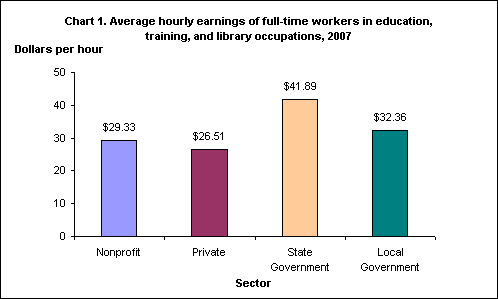 Elementary and middle school teachers. Teachers at public elementary and secondary schools are required to have a teaching certification, but teachers at private schools may not have this requirement. As shown in chart 2, below, elementary and middle school teachers at private schools earned, on average, $25.34 per hour, which is lower than the hourly rate for teachers at public elementary and middle schools ($35.56).14 Elementary and middle school teachers earned $25.32 per hour at private nonprofits, which is 30 percent less than the earnings of teachers employed by State and local governments. 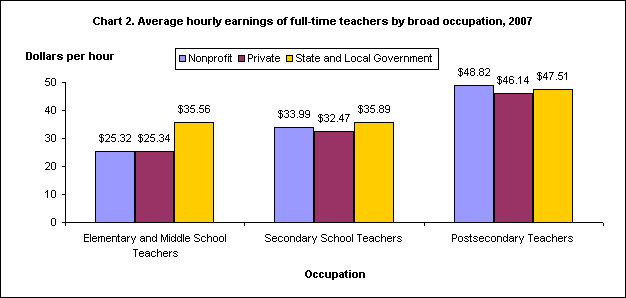 Secondary school teachers. Secondary school teachers, who teach at high schools and secondary vocational schools, often teach one or two subjects. Private secondary school teachers earned an average of $32.47 per hour, which is less than what secondary school teachers at public schools earned ($35.89 per hour). The hourly earnings of secondary school teachers at private nonprofit schools ($33.99) were not statistically different from those at public schools. Postsecondary school teachers. Colleges, universities, and vocational schools are postsecondary schools. Unlike elementary and secondary school teachers, postsecondary teachers are further separated into specific occupations by the subject that they teach. For example, a professor of biology would be classified in the category Biological Science Teachers, Postsecondary. A postsecondary teacher who does a combination of both teaching and research is classified as a teacher. Postsecondary school teachers earned similar wages at nonprofits ($48.82 per hour), at all private schools ($46.14 per hour), and at public postsecondary schools ($47.51 per hour). Librarians. Librarians are employed by schools, private establishments, and governments. The average hourly wage of librarians at private nonprofits ($25.37) was not significantly different from those at State and local governments ($27.98) but lower compared to those in private industry ($31.96). Education administratorsThe occupation education administrator is a management occupation commonly found in educational institutions. Education administrators coordinate research activities, academic programs, or student admissions. Education administrators at private nonprofit establishments earned, on average, $31.39 per hour, less than their counterparts at State and local governments ($42.15 per hour)15 but not significantly different from those in private industry ($29.20 per hour). Educational, vocational, and school counselorsEducational, vocational, and school counselor is one occupation in the community and social services occupational group. These counselors work with students or as curriculum counselors. The average hourly wages of educational, vocational, and school counselors employed by nonprofits ($21.02) were less than those of their counterparts at State and local governments ($34.58 per hour)16 but not significantly different from those in private industry ($20.80 per hour). Life, physical, and social science occupationsLife, physical, and social science occupations can be found at academic institutions, research organizations, private businesses, and State and local public health departments. This occupational group includes biologists, chemists, and social scientists, as well as clinical, counseling, and school psychologists. As chart 3 shows, the average hourly wages of life, physical, and social science occupations at nonprofits ($26.95) were less than those in all private industry ($31.27) and in local governments ($30.16), but they were similar to those at State governments ($24.56). 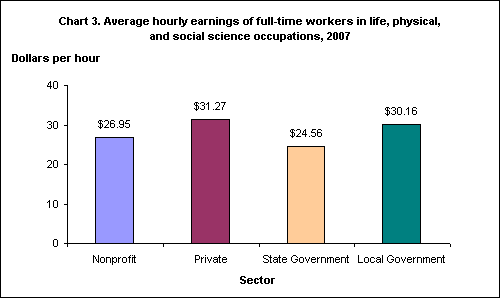 Architecture and engineering occupationsState and local governments employ workers in architecture and engineering occupations in their environmental protection and health and safety agencies. Private sector businesses, such as architecture design firms, employ such workers as well. In the nonprofit sector, these occupations are often found at academic institutions and research organizations. As chart 4 shows, the average hourly wages of architecture and engineering occupations at nonprofit establishments ($36.37) were higher than the wages of workers in these occupations at State governments ($29.30) and at local governments ($29.64). Wages of nonprofit workers in these occupations did not differ significantly from those of workers in all private industry establishments ($33.36 per hour). For engineers specifically, the average hourly wages at nonprofits ($44.72) were higher, compared with those of all private industry ($39.09) and State and local governments ($33.97).17 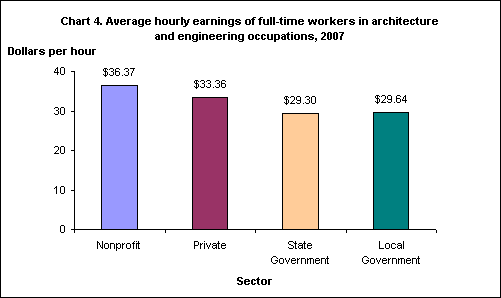 Food preparation and serving occupationsThese workers can be found at school cafeterias, as well as at restaurants, hospital cafeterias, and nursing home kitchens. As chart 5 shows, food preparation and serving related workers employed by private industry establishments earned an average of $9.15 per hour, which is less than what these workers earn at nonprofit establishments ($11.92 per hour). The average hourly wages of nonprofit food preparation and serving related workers were very similar to the average hourly wages of local government workers ($11.90), but they were less than those of State government workers ($14.12). 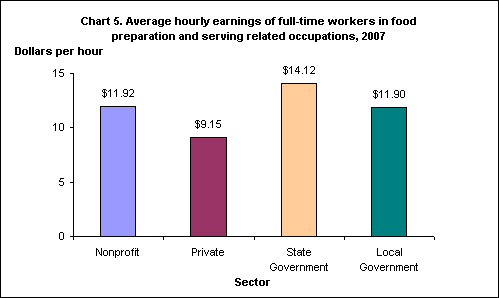 Building and grounds cleaning and maintenance occupationsJanitors, housekeepers, and grounds maintenance workers are employed by schools, hospitals, businesses, and companies that contract these services. As chart 6 shows, workers in these occupations earned less at nonprofits ($12.07 per hour) than at local governments ($14.44 per hour). Building and grounds cleaning and maintenance occupations at private industry establishments earned, on average, $11.83 per hour, which is very similar to the average hourly wage at private nonprofit establishments and at State governments ($11.53 per hour). 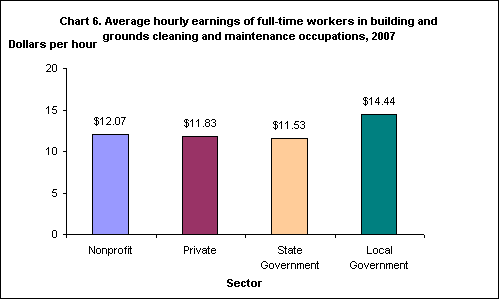 SummaryData from the 2007 National Compensation Survey were used to compare the wages of full-time workers in nonprofit organizations, all private industry, State government, and local government organizations, and the following results were found:
NOTE: Data for private industry in this article have been revised. When the article was originally published, the tabulations for private industry incorrectly included State and local government workers, in addition to private sector workers. The error has been corrected.
Notes1 Data on the total number of tax-exempt organizations are from Internal Revenue Service Data Book 2007, Publication 55B (Internal Revenue Service, March 2008), table 25; available on the Internet at http://www.irs.gov/taxstats/article/0,,id=168593,00.html. Churches are not required to apply for recognition of tax-exemption. 2 See Christopher J. Ruhm and Carey Borkoski, "Compensation in the Nonprofit Sector," The Journal of Human Resources, autumn 2003, pp. 992-1021. 3 Private industry includes both nonprofit and for-profit establishments. Separate wage estimates for employees of for-profit establishments were not available. 4 National Compensation Survey: Occupational Earnings in the United States, 2007, Bulletin 2704 (Bureau of Labor Statistics, August 2008); available on the Internet at http://www.bls.gov/ncs/ncswage2007.htm. The National Compensation Survey (NCS) has always included nonprofit establishments in its private industry measures of occupational earnings, compensation cost trends, benefit incidence, and detailed benefits provisions. For more information on the National Compensation Survey, see BLS Handbook of Methods, Chapter 8, "National Compensation Measures," available on the Internet at http://www.bls.gov/opub/hom/homtoc.htm. 5 Occupations are classified according to the 2000 Standard Occupational Classification (SOC) system, which categorizes more than 800 individual occupations into 23 major groups. The National Compensation Survey does not survey agriculture, Federal government, military, or private household employers. For more information on the detailed occupations included in each major occupational group, see National Compensation Survey: Occupational Earnings in the United States, 2007, appendix B; available on the Internet at http://www.bls.gov/ncs/ocs/sp/ncbl0841.pdf. 6 For the 2006-07 period, 1,640 of a total of 4,314 degree-granting institutions were private not-for-profit and 208 of a total of 2,222 non-degree-granting Title IV institutions offering postsecondary education were private not-for-profit. See Digest of Education Statistics: 2007 (National Center for Education Statistics, March 2008), tables 255 and 359; available on the Internet at http://nces.ed.gov/programs/digest/2007menu_tables.asp. 7 In the fall of 2006, among a total of 18,205,474 students, 3,543,455 were enrolled in private not-for-profit Title IV institutions. In addition, among 8,666,183 undergraduate students enrolled in the fall of 2006, 2,409,256 were enrolled in 4-year private not-for-profit undergraduate schools. See Enrollment in Postsecondary Institutions, fall 2006; Graduation Rates, 2000 and 2003 Cohorts; and Financial Statistics, Fiscal Year 2006 (National Center for Education Statistics, June 2008), table 1; available on the Internet at http://nces.ed.gov/pubs2008/2008173.pdf. 8 Private elementary and secondary schools include both nonprofit and for-profit schools. 9 In 2005-06, there were 28,996 private elementary and secondary schools. See Characteristics of Private Schools in the United States: Results from the 2005-2006 Private School Universe Survey (National Center for Education Statistics, March 2008), table 1; available on the Internet at http://nces.ed.gov/pubs2008/2008315.pdf. There were 97,382 public elementary and secondary schools in 2006-07. See Digest of Education Statistics: 2007 (National Center for Education Statistics, March 2008), table 91; available on the Internet at http://nces.ed.gov/programs/digest/d07/tables/dt07_091.asp. 10 In 2005-06, there were 5,057,520 students enrolled in private elementary and secondary schools. See Characteristics of Private Schools in the United States: Results from the 2005-2006 Private School Universe Survey, (National Center for Education Statistics, March 2008), table 1. There were 48,912,085 students enrolled in public elementary and secondary schools in 2005-06. See Digest of Education Statistics: 2007 (National Center for Education Statistics, March 2008), table 91. 11 Ruhm and Borkoski, "Compensation in the Nonprofit Sector"; also, Laura Leete, "Whither the Nonprofit Wage Differential? Estimates from the 1990 Census," Journal of Labor Economics, January 2001, pp. 136-170. 12 That is, those workers who are classified in the same occupations according to the 2000 Standard Occupational Classification (SOC) system. 13 Statements of comparisons in this article are significant at a standard error level of 1.645 or more (90-percent confidence level), unless indicated otherwise. See table 1 for wage estimates and the corresponding relative standard errors. 14 The wage estimate for teachers of public schools is the combined wage estimate for teachers in the State and local government sectors. 15 Combined wage estimate for State and local government workers. 16 Combined wage estimate for State and local government workers. 17 Combined wage estimate for State and local government workers.
|
Tools |
Calculators |
Help |
Info |